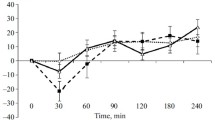Abstract
The effects of compounds active at histamine H3-receptors on morphine-induced antinociception have been investigated in thermal and chemical tests in mice; tail-immersion (50°C) and hot-plate (49° and 55°C) tests and acetic acid-induced writhing. Neither (R)α-methylhistamine, a specific agonist, (S)α-methylhistamine, a chemical control, nor thioperamide, an antagonist, had any antinociceptive action alone but thioperamide (3 mg kg−1) attenuated the effects of morphine in the tailimmersion test wile (R)α-methylhistamine (1 mg kg−1), but not the (S) isomer, potentiated its effects in the hot-plate test at 55°C. These results are consistent with the morphine potentiation seen with H1-antagonists and suggest that central histaminergic mechanisms can modulate opioid actions.
Similar content being viewed by others
References
P. Freeman and G. Sturman,Potential of morphine-induced antinociception in mice by centrally but not peripherally acting histamine H 1 antagonists. Br. J. Pharmacol.97, 486P (1989).
P. Freeman and G. Sturman,Histamine H 2 antagonists and nociception in the mouse. Br. J. Pharmacol.101, 556P (1990).
D. LuttingerDetermination of antinociceptive efficacy of drugs in mice using different water temperatures in a tail-immersion test. J. Pharmacol. Methods13, 351–357 (1985).
J.-M. Arrang, M. Garbarg, J-C. Lancelot, J.-M. Lecomte, H. Pollard, M. Robba, W. Schunack and J-C. Schwartz,Highly potent and selective ligands for histamine H 3-receptors. Nature327, 117–123 (1987).
S. M. Owen, G. Sturman and P. Freeman,Modulation of nociception in mice by histamine H 3-receptor ligands. Br. J. Pharmacol.106, 139P (1992).
H. Timmerman,Histamine H 3 ligands: just pharmacological tools or potential therapeutic agents? J. Med. Chem.33, 4–11 (1990).
M. Garbarg, J-M. Arrang, A. Rouleau, X. Ligneau, M. Dam Trung Tuong, J-C. Schwartz and R. Ganellin,S-[2-(4-imidazolyl)ethyl]isothiourea, a highly specific and potent histamine H 3 receptor agonist. J. Pharmacol. exp. Therap.263, 304–310 (1992).
Author information
Authors and Affiliations
Rights and permissions
About this article
Cite this article
Owen, S.M., Sturman, G. & Freeman, P. Modulation of morphine-induced antinociception in mice by histamine H3-receptor ligands. Agents and Actions 41 (Suppl 1), C62–C63 (1994). https://doi.org/10.1007/BF02007768
Issue Date:
DOI: https://doi.org/10.1007/BF02007768




